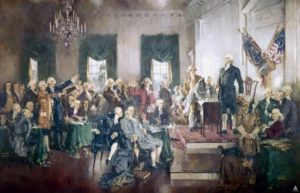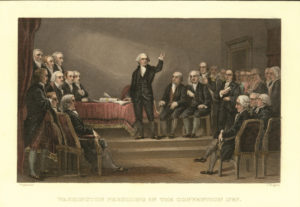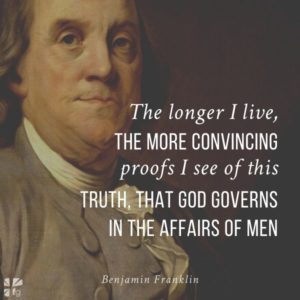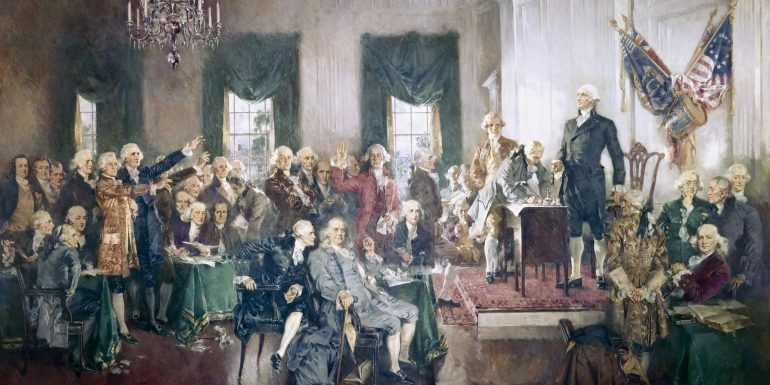 On May 25, 1787 – 235 years ago – the Constitutional Convention began its deliberations in Philadelphia. This was the culmination of decades of attempts to properly define and put into operation a covenant between the colonies that would balance the self-government of each entity with the strength of unity necessary to defend national sovereignty. The Articles of Confederation, ratified in 1781, were found deficient, leaning so far towards state sovereignty that national unity appeared to vanish.
On May 25, 1787 – 235 years ago – the Constitutional Convention began its deliberations in Philadelphia. This was the culmination of decades of attempts to properly define and put into operation a covenant between the colonies that would balance the self-government of each entity with the strength of unity necessary to defend national sovereignty. The Articles of Confederation, ratified in 1781, were found deficient, leaning so far towards state sovereignty that national unity appeared to vanish.
After the Peace Treaty of 1783, the nation experienced alarming instances of anarchy. Freedom is dangerous when it is not “liberty under law.” Anarchy, that resists law altogether, is the typical swing of the pendulum from tyranny, or total law. Both the clergy who had helped lead the Revolution, and the Statesmen who were attempting to preserve its liberty, were concerned. George Washington had lamented, “I do not conceive we can exist long as a nation without having lodged somewhere a power which will pervade the whole Union in as energetic a manner as the authority of the state governments….”
 Maryland and Virginia were in a quarrel over the navigation of the Potomac, and in 1785 they sent commissioners to Mt. Vernon. By 1786 they realized more states were affected and desired to expand it. There they recommended to the Continental Congress that they appoint delegates “on the second of May next, to take into consideration the trade and commerce of the United States.” Also, each colony had their own currencies, most of which were not accepted in other Colonies. So in May of 1787, the suspense was great – would enough colonies attend such a convention to properly address these issues? By the 25th, delegates from all but Rhode Island (who boycotted the convention) were in attendance.
Maryland and Virginia were in a quarrel over the navigation of the Potomac, and in 1785 they sent commissioners to Mt. Vernon. By 1786 they realized more states were affected and desired to expand it. There they recommended to the Continental Congress that they appoint delegates “on the second of May next, to take into consideration the trade and commerce of the United States.” Also, each colony had their own currencies, most of which were not accepted in other Colonies. So in May of 1787, the suspense was great – would enough colonies attend such a convention to properly address these issues? By the 25th, delegates from all but Rhode Island (who boycotted the convention) were in attendance.
Many felt that the presence of George Washington at such a convention was a necessity, for he held such respect among all the colonies. He was elected President of the Convention, and rose to declare:
“It is too probable that no plan we propose will be adopted. Perhaps another dreadful conflict is to be sustained. If to please the people, we offer what we ourselves disapprove, how can we afterward defend our work? Let us raise a standard to which the wise and the honest can repair. The event is in the hand of God.”
Perhaps this sentiment correctly assessed the task: “John Adams had not been far wrong when he said that from the beginning he had seen more difficulty from our attempts to govern ourselves than from all the fleets and armies of Europe.” Self-government requires each individual, town, and state to take greater responsibility for their own affairs. It is not an easy way to govern, and in history it is quite rare. But, with God’s help, it is possible, and is the best way to preserve liberty for ourselves and our posterity.
The convention quickly moved from adjusting the Articles (with a weak national government) to proposing a new Constitution with the introduction of the Virginia Plan (favoring a stronger national government). The great debate that dominated much of the convention was a national vs. federal government. The former favored a strong central government and the latter favored the self-government of the States. It is interesting to note that of the 55 delegates that attended, 52 were probably orthodox Christians. There were 27 Episcopalians, 10 Presbyterians, and 6 Congregationalists. Most likely their perspectives on civil government would come from their perspectives of ecclesiastical government.
Writing from London in early 1787, John Adams wrote that the three forms of government should be represented: “Three branches of power (monarchy, aristocracy, democracy) have an unalterable foundation in nature…if all of them are not acknowledged in any constitution of government, it will be found to be imperfect, unstable, and soon enslaved.” John Dickinson gave the analogy of a solar system “in which the States are the planets, and ought to be left to move freely in their proper orbits.”
 But how to blend these powers nearly doomed the convention to failure. The New Jersey Plan (States-dominant) had countered the Virginia Plan (national government-dominant). Toward the end of June it appeared to split the convention, and then Franklin made his famous plea for prayer. In it, he declared that they had been “groping as it were in the dark to find political truth.” He then questioned, “How has it happened, sir, that we have not hitherto once thought of humbly applying to the Father of Lights to illuminate our understandings?” He continued, “Have we now forgotten that powerful friend? Or do we imagine we no longer need his assistance?” For emphasis he concluded, “We have been assured, sir, in the Sacred writings, that ‘except the lord build the house, they labor in vain that build it.’ …without his concurring aid, we shall succeed in this political building no better than the builders of Babel.”
But how to blend these powers nearly doomed the convention to failure. The New Jersey Plan (States-dominant) had countered the Virginia Plan (national government-dominant). Toward the end of June it appeared to split the convention, and then Franklin made his famous plea for prayer. In it, he declared that they had been “groping as it were in the dark to find political truth.” He then questioned, “How has it happened, sir, that we have not hitherto once thought of humbly applying to the Father of Lights to illuminate our understandings?” He continued, “Have we now forgotten that powerful friend? Or do we imagine we no longer need his assistance?” For emphasis he concluded, “We have been assured, sir, in the Sacred writings, that ‘except the lord build the house, they labor in vain that build it.’ …without his concurring aid, we shall succeed in this political building no better than the builders of Babel.”
At that time preachers were paid to pray, and without a budget, they did not want to bring a preacher in and make it look like they were failing. So presumably, each prayed individually. And God answered! In early July the Connecticut Compromise was introduced, where part of Congress would represent the people with 2-year terms (democracy), and part would represent the States with 6-year terms (aristocracy). The President would have a term for 4 years (monarchy). This unique balance was a picture of Biblical covenant where both a vertical and horizontal identity was clear.
 Due to the dominance of Biblical reasoning from the delegates, scriptural ideas were in the Constitution, such as honoring Sunday, money resting on a gold standard, no standing army, the leader must not be an immigrant, appellate justice, law and equity, and local justice, to name a few. As the convention drew to a close, Ben Franklin remarked that the sun on the back of the President’s chair could be rising or setting. He then stated, “At length I have the happiness to know that it is a rising and not a setting Sun.”
Due to the dominance of Biblical reasoning from the delegates, scriptural ideas were in the Constitution, such as honoring Sunday, money resting on a gold standard, no standing army, the leader must not be an immigrant, appellate justice, law and equity, and local justice, to name a few. As the convention drew to a close, Ben Franklin remarked that the sun on the back of the President’s chair could be rising or setting. He then stated, “At length I have the happiness to know that it is a rising and not a setting Sun.”
The Constitution is not perfect, and neither were the delegates who drafted it. But still, as Catherine Bowen writes, “Miracles do not occur at random, nor was it the author of this book who said there was a miracle at Philadelphia in the year 1787. George Washington said it, and James Madison.” The ratification debates within the States were intense. These, along with the Federalist and Anti-Federalist papers, remain the most precious primary sources on the intent of the framers. Let us pray that we will one day return to a constitutional government that upholds the self-government we must practice if we are to truly be one nation under God.







